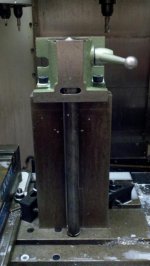Yes, you can.
I have some shafts that I have to drill and tap and chamfer the ends and maintain depth control of +-.02". I have made a special extension for my 5C collet holder that allows it to accept up to 19" long shafts and still hold dead length. The holder mounts on a 12" tall angle plate and for the longest ones I even use a 1" extension on top of that and it all hangs just over the edge of the table in order to get it to fit at all.
Two things you have to do. When you touch off your tools, you need to raise the tool above the part, touch it off of the top, set it and then move your part away before going to the next tool. You will be setting your tools above the tool change position (plus number in the offset) and if you were to hit next tool or do a tool change it will slam down into the part. All tools must be done this way.
Next, when you write your program, you must have all tool changes away from the part. At the beginning, have your part way to the right of the spindle. It must be to the right and or front, in order to keep it away from the tool changer as well as the spindle. Even if you have a shorter tool, the swing of the tools can hit the part.
When the tool is changed, it will end up at the normal tool change height. When you call up the offset in the program, the tool will actually go up then and then you move it over to your part or location. Normal tool cutting/etc. action, then before you do a tool change for the next tool, move the part again. Do not call a "G00 G01 G28 Z0." over the part either or that will send the tool into the part. Do this for all tools, then at the end of the program, move the part to the right/front again before ending the program.
It looks scary as hell when you are setting it up, but after you have checked it out and make sure you have clearance, you can push the button and it will run without crashes, and still look scary!

In the attached picture, the fixture is setup for shafts that are only about 14.5 inches long. For the longer ones, there is an extension for the fixture and the rig hangs over the front edge of the table. Thankfully on the Haas, the machinable area extends past the actual table itself. 14" table and 16 inch machinable area for "Y".
Good luck----Mike



